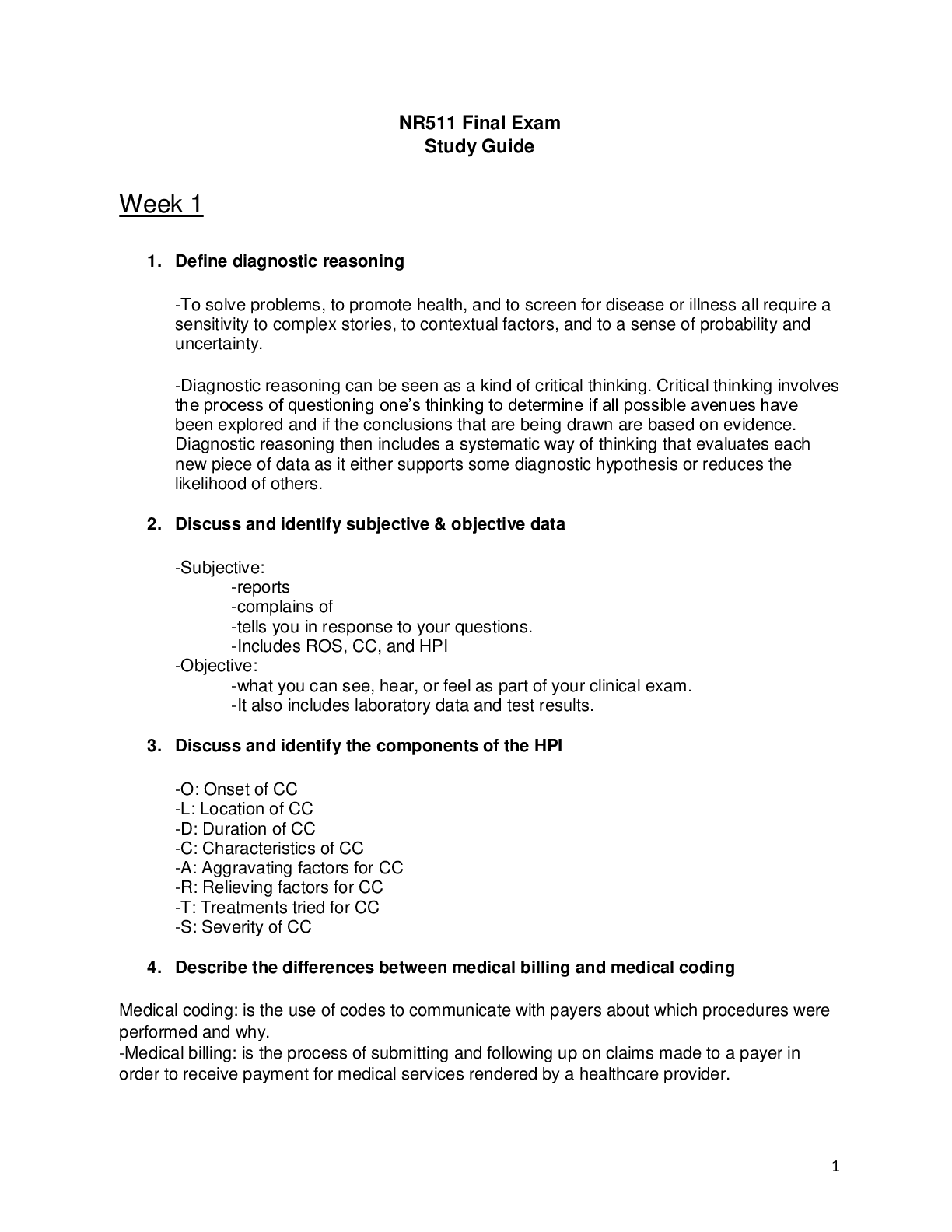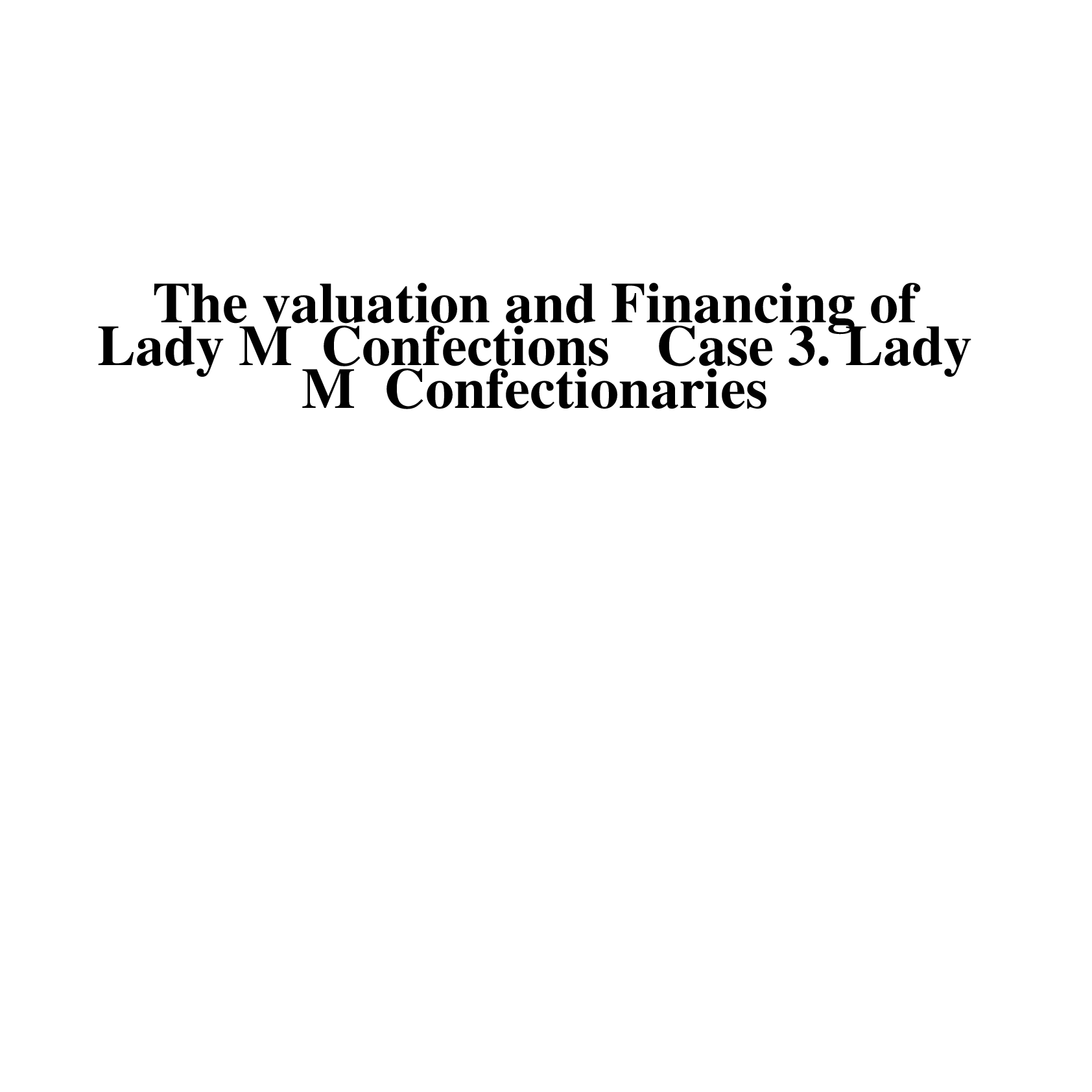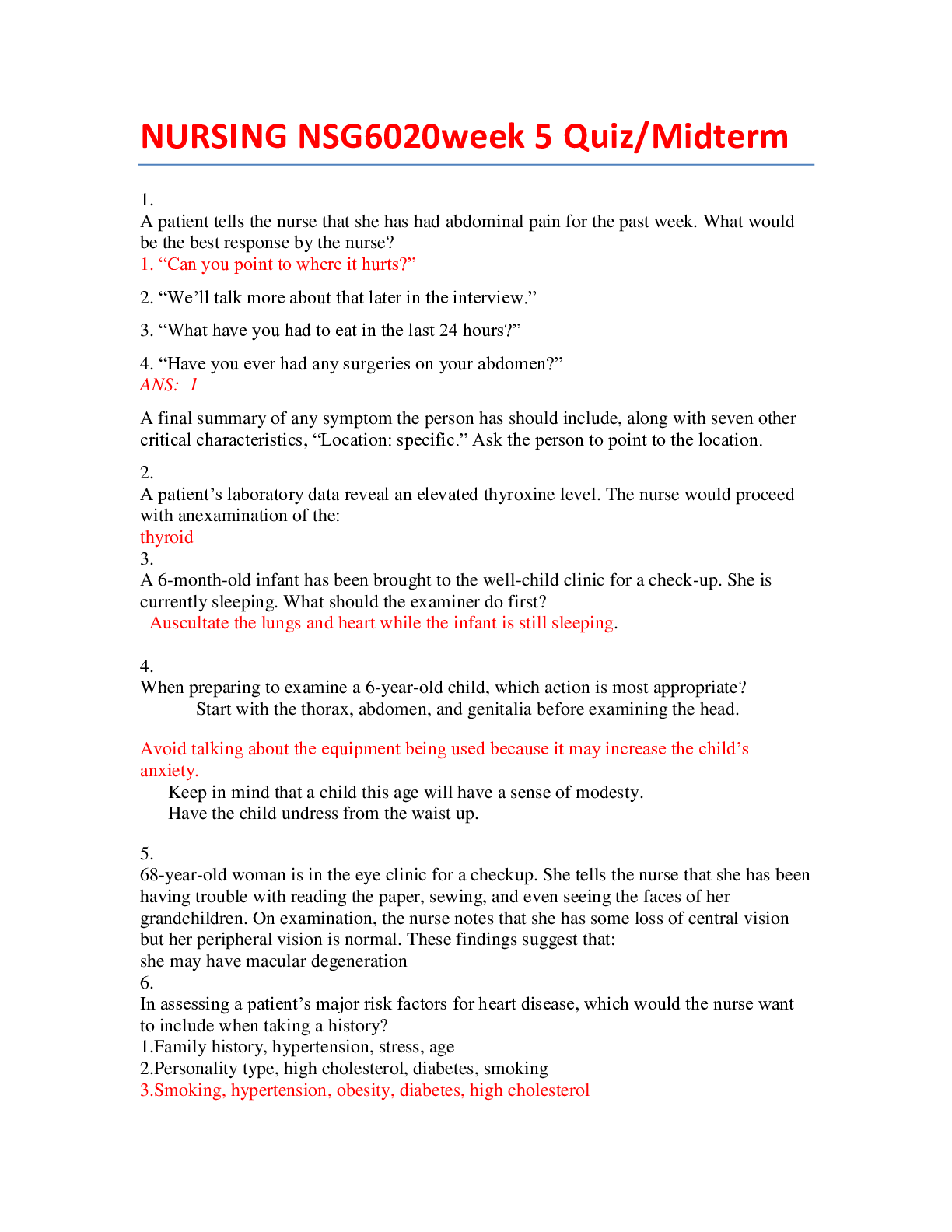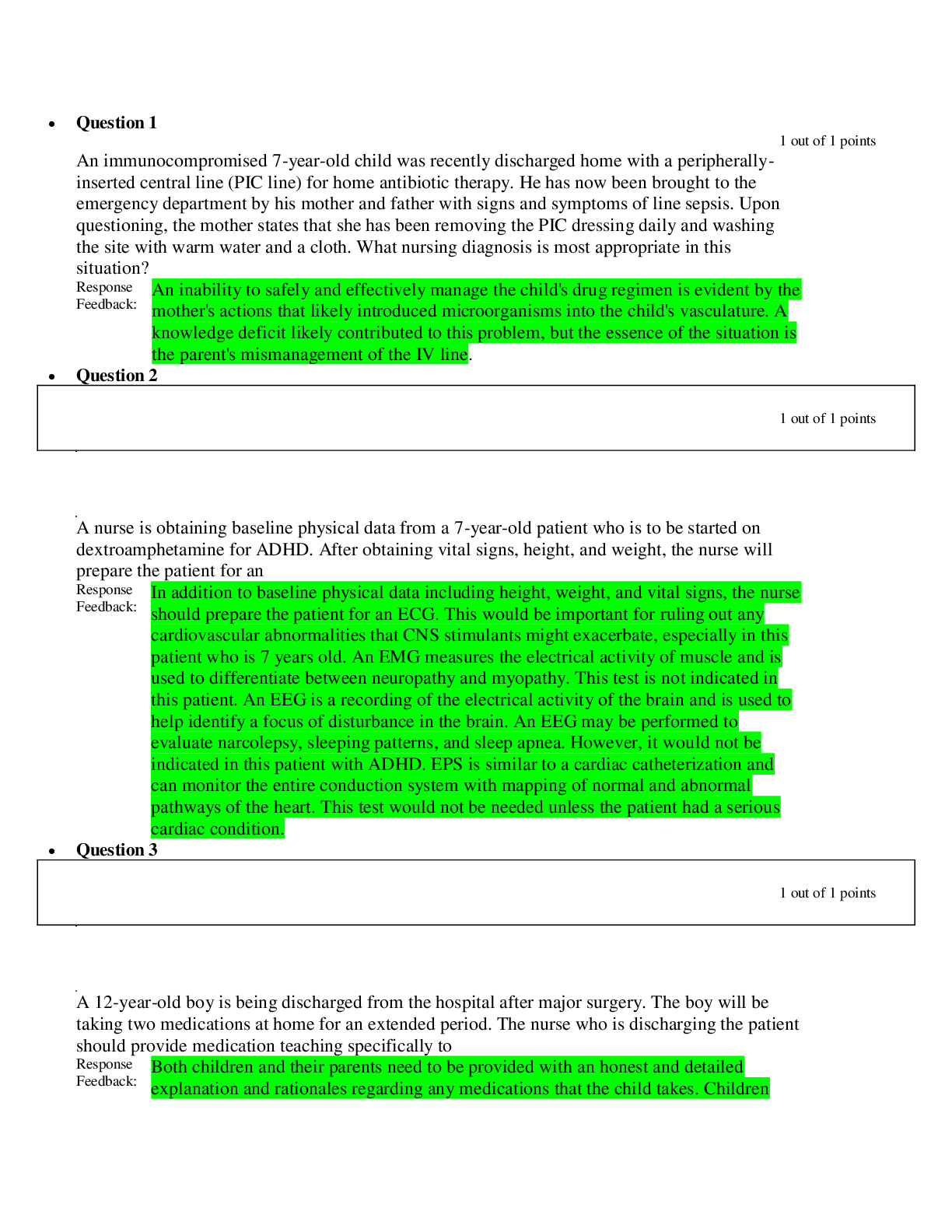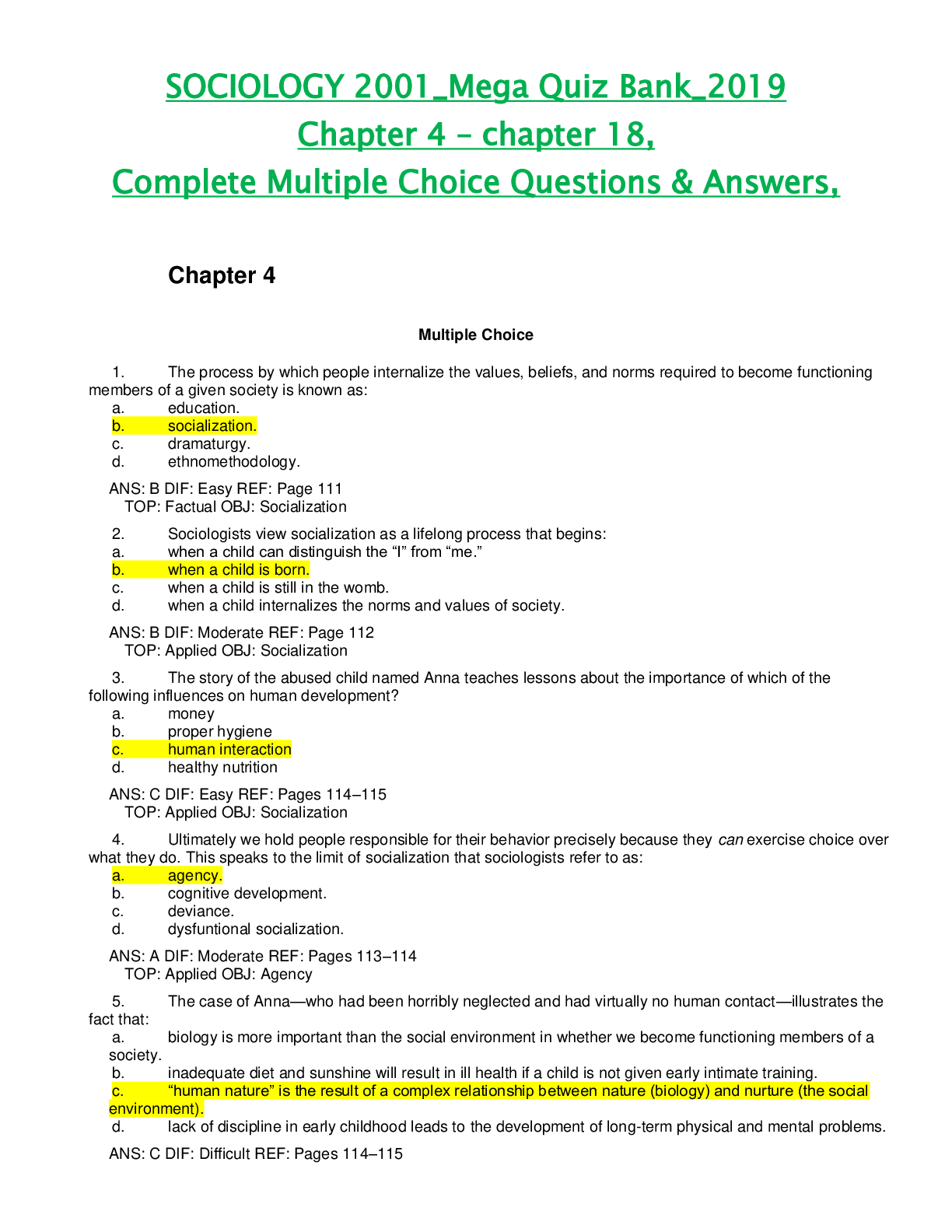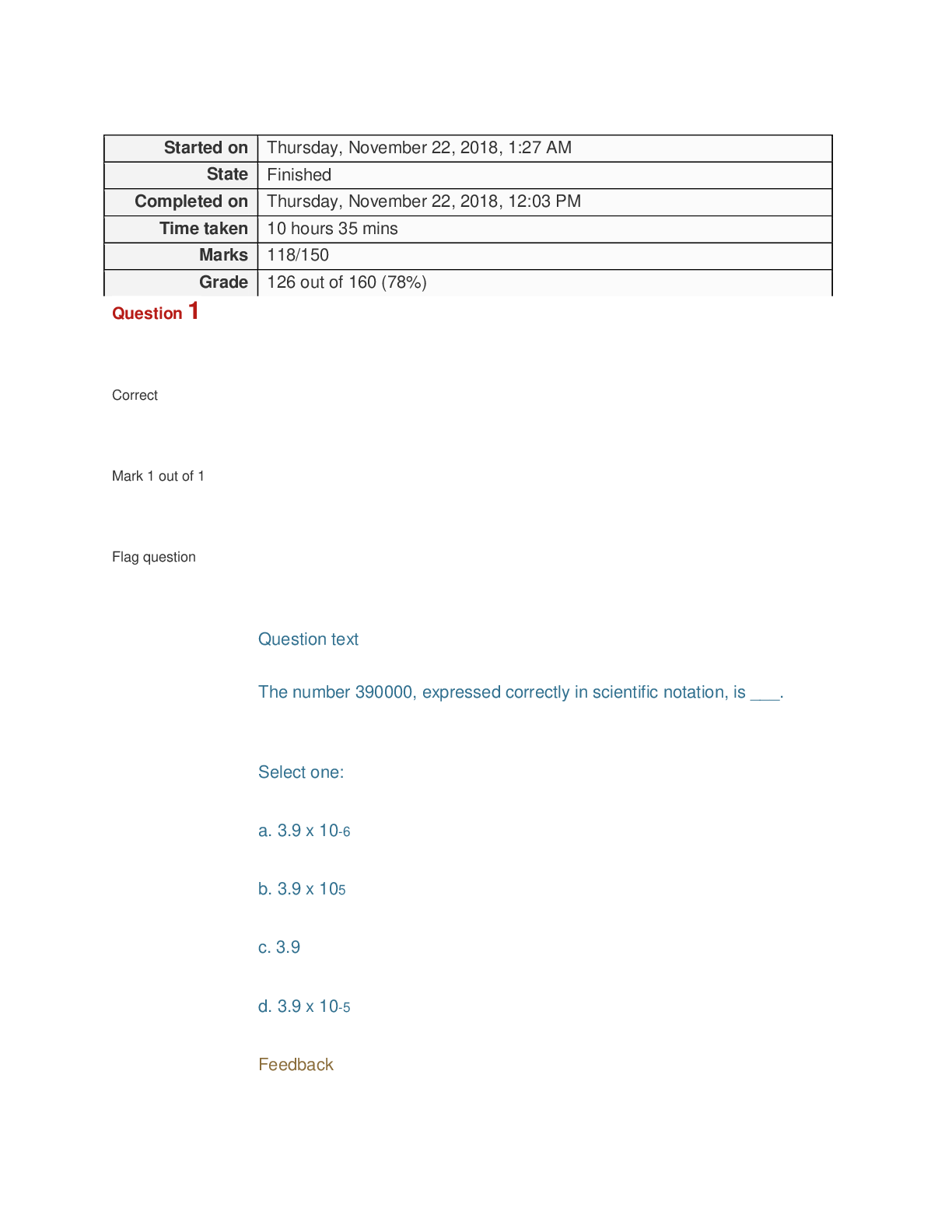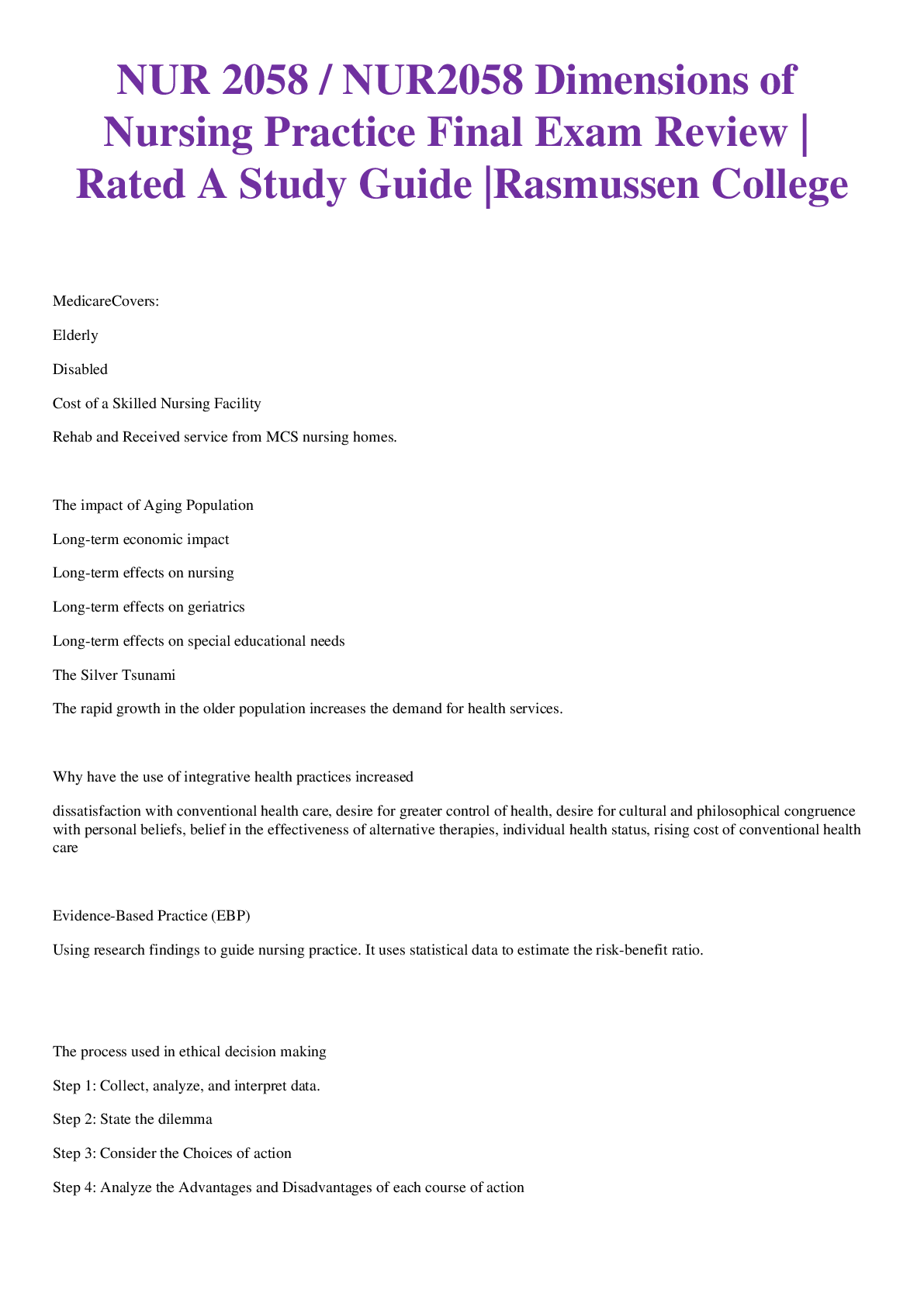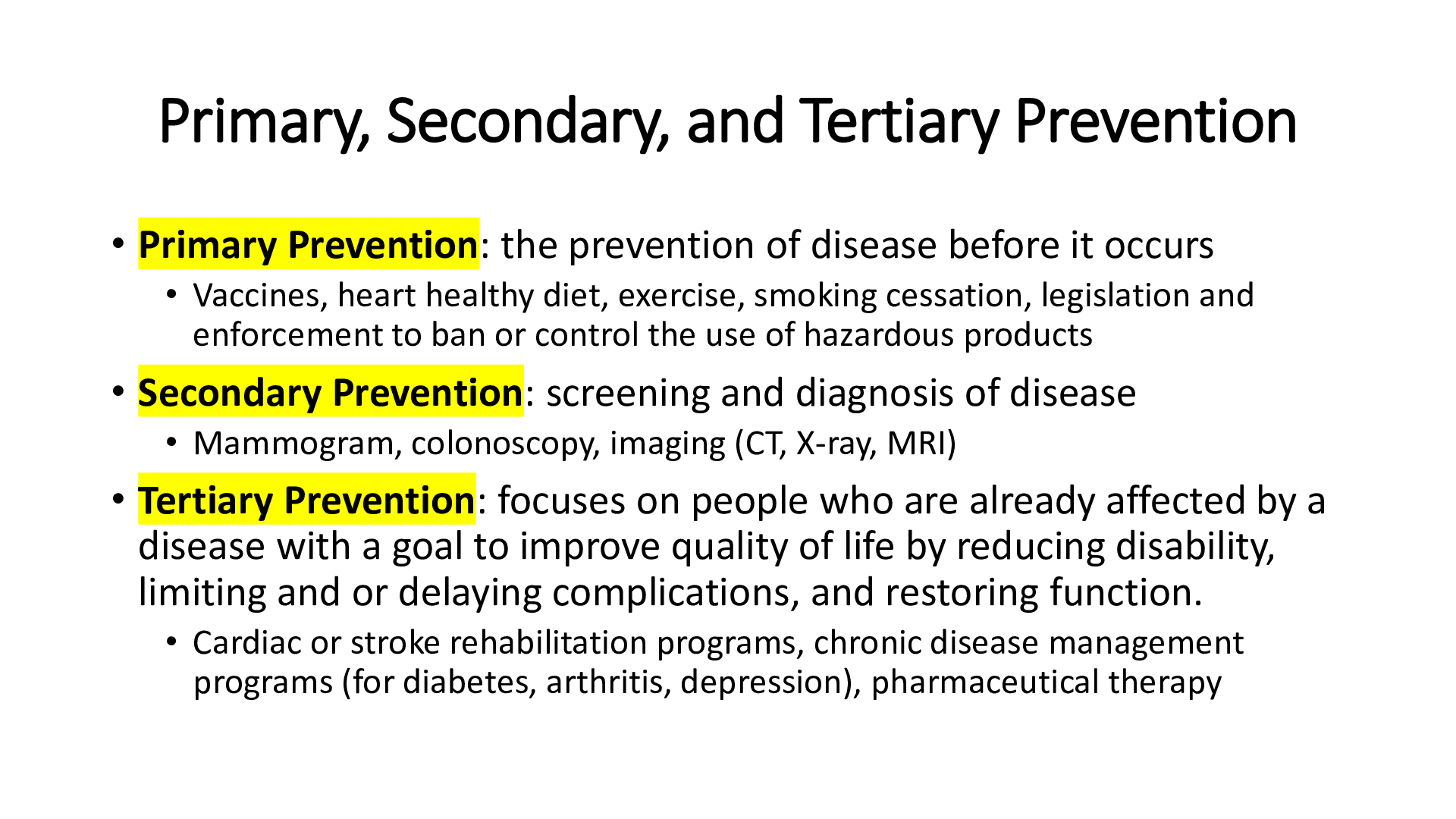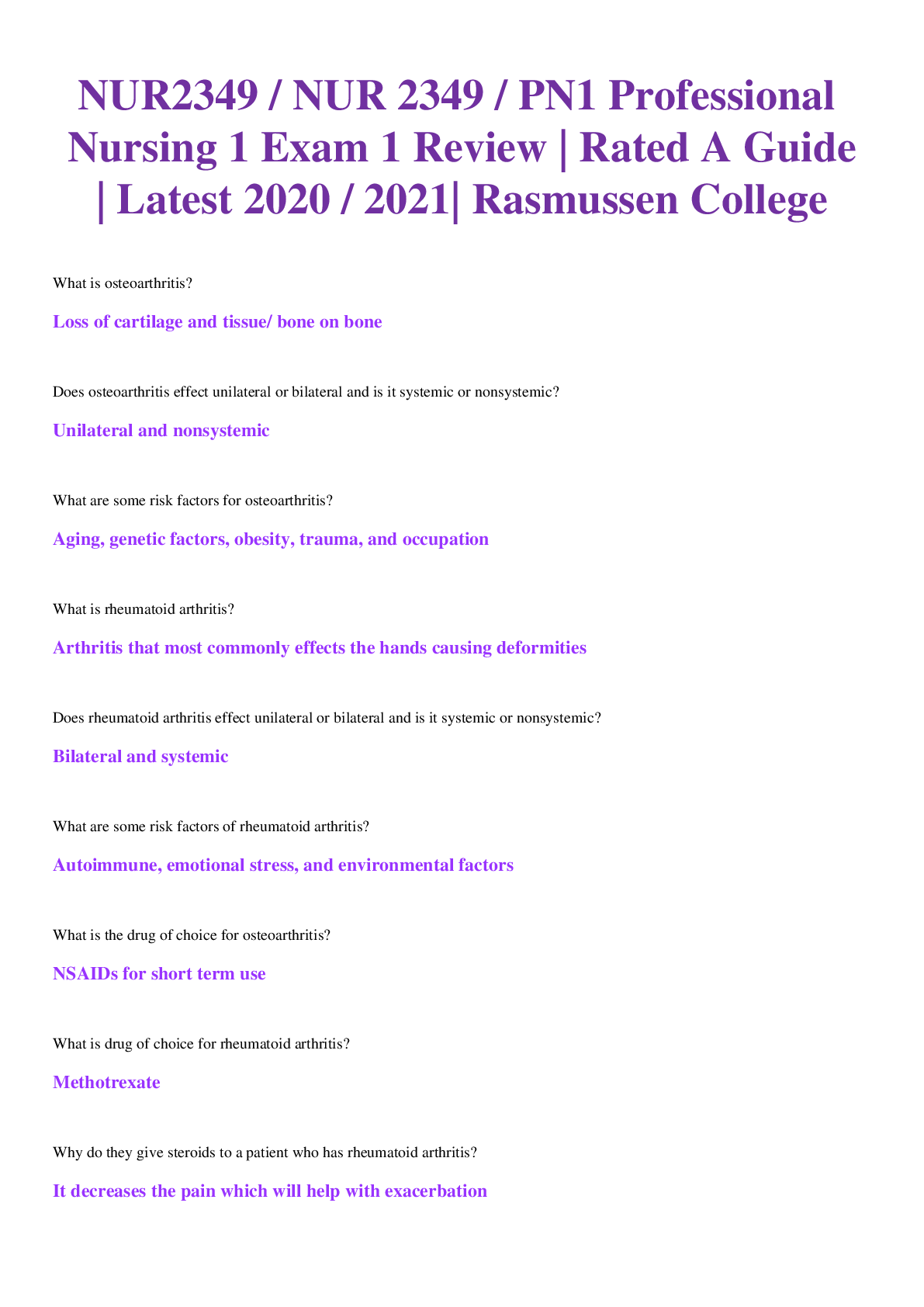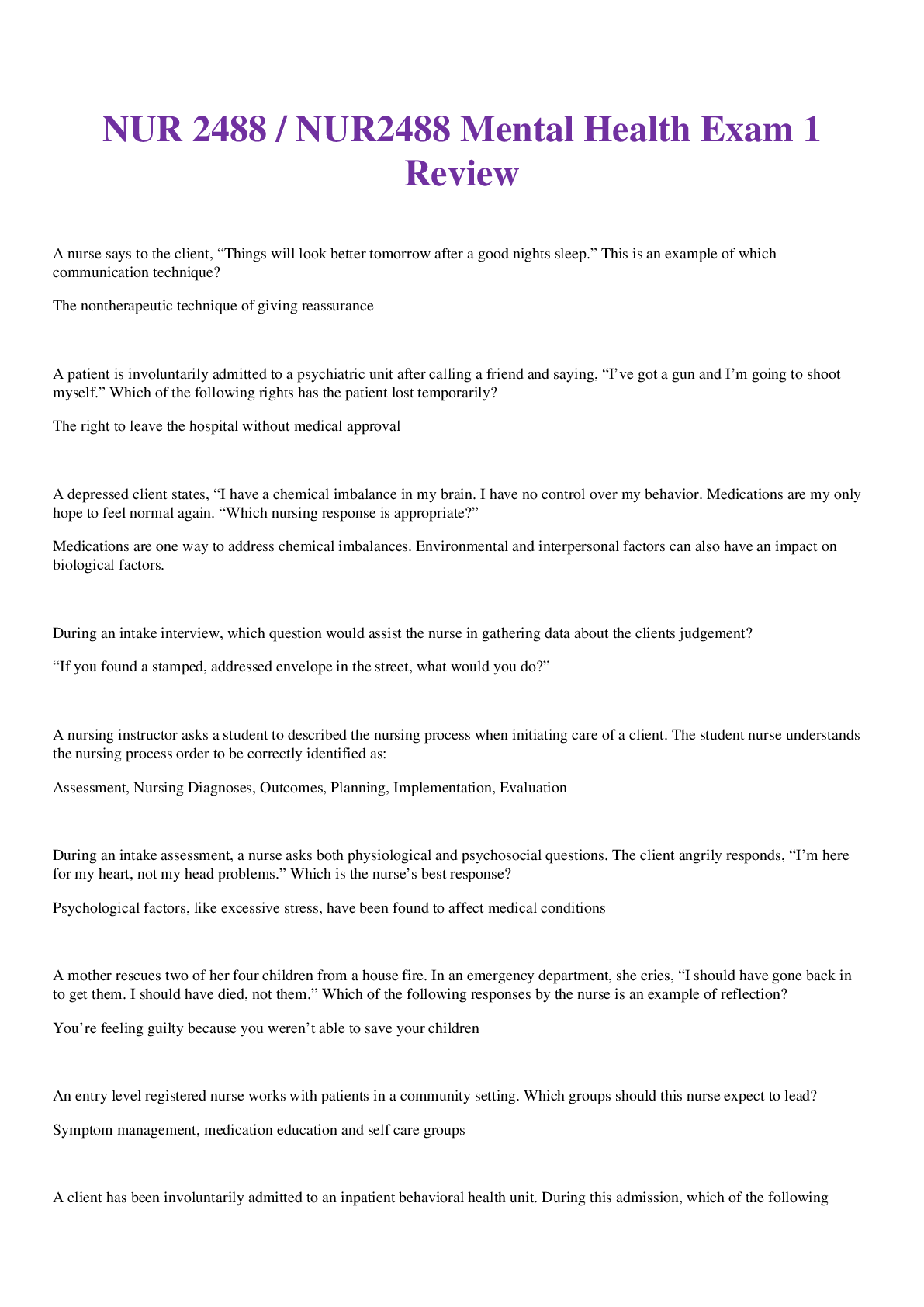*NURSING > EXAM REVIEW > ATI PEDIATRIC Proctored Exam ( LATEST ) GRADED A (All)
ATI PEDIATRIC Proctored Exam ( LATEST ) GRADED A
Document Content and Description Below
ATI PEDIATRIC Proctored Exam ( LATEST ) ATI PEDIATRIC Proctored Exam ( New 2020 / 2021 ) ATI PEDIATRIC Version 1 1. A nurse is collecting date from a school-age child. The nurse should identify that w... hich of the following findings is a manifestation of physical abuse? a) Multiple dental caries b) Malnutrition c) Recurrent urinary tract infections d) Bruises at various stages of healing 2. A nurse is reinforcing teaching with an adolescent who has an inflamed nonperforated appendix and is scheduled for a laparoscopic assisted appendectomy. Which of the following instructions should the nurse include in the teaching? a) “You can begin drinking fluids again 2 days after your surgery.” b) “You will need to ask for pain medication for the first 24 hours after surgery.” c) “You will have your vital signs monitored every 8 hours after surgery.” d) “You will sit in your chair at least twice a day after surgery.” 3. A nurse is reinforcing teaching about sudden infant death syndrome (SIDS) with the parent of a 1-month-old infant. Which of the following statements by the parent indicates an understanding of the teaching? a) “I will let my baby sleep with me in bed at night.” b) “I will allow my baby to have a pacifier while sleeping.” c) “I will place my baby on a soft mattress to sleep.” d) “I will cover my baby with a quilt while he sleeping.” 4. A nurse is assisting with the care of a child who is postoperative and received a transfusion during a surgical procedure. Which of the following findings indicates the child is havig a hemolytic reaction? a) Chills and flank pain b) Pruritus and flushing c) Rales and cyanosis d) Bradycardia and diarrhea 5. A guardian calls the clinic nurse after his child has developed symptoms of varicella and asks when his child will no longer be contagious. Which of the following responses should the nurse make? a) “When your child no longer has a fever.” b) “Three days after the rash started.” c) “Six days after lesions appear if they are crusted.” d) “When your child’s lesions disappear.” 6. A nurse is collecting date from a child during a well-child visit. The nurse should recognize that which of the following findings places the child at a higher risk for abuse? a) The child is 6 years old. b) The child is male. c) The child was born at 30 weeks of gestation. d) The child was born via cesarean birth. 7. A nurse is reinforcing teaching with the guardian of a child who has a new diagnosis of rheumatic fever. Which of the following statements by the guardian indicates an understanding of the teaching? a) “I should not give my child aspirin for pain or fever.” b) “My child will take antibiotic for 6 months.” c) “My child might have a period of irregular movement of the extremities.” d) “I should expect there to be blood in my child’s urine.” 8. A nurse is collecting data from an infant during a well-child visit. Which of the following sites should the nurse use when obtaining the infant’s heart rate? a) Apical b) Radial c) Carotid d) Femoral 9. A nurse is preparing a toddler for suturing of a minor facial laceration. The nurse should place the toddler in which of the following restraints? a) Mummy restraint b) Jacket restraint c) Elbow restraint d) Wrist restraint 10. A nurse is reinforcing dietary teaching with the parent of a 2-year-old toddler. Which of the following should the nurse include in the teaching? a) "It is recommended that the toddler consumes no more than 12 ounces of fruit juice each day." b) "An appropriate serving size is 1 tablespoon of food per year of age." c) "Introduce healthy finger foods like carrots and celery sticks." d) "Encourage 5 cups of low-fat milk each day." 11. During a well-child visit, the parent of a toddler expresses concern to the nurse that the toddler takes several hours to fall asleep at night. Which of the following recommendations should the nurse make? a) Vary the time the toddler goes to bed each night b) Allow the toddler to watch television before bedtime c) Provide the toddler with a favorite toy at bedtime. d) Increase the toddler's activity prior to bedtime 12. A nurse is assisting with the care for a 7-month-old infant who has a cleft palate. Which of the following actions should the nurse take to decrease the infant’s risk for aspiration? a) Feed the infant in supine position. b) Encourage the mother to breastfeed the infant exclusively. c) Burp the infant frequently during feedings. d) Perform nasotracheal suctioning if coughing occurs 13. A nurse is reviewing the laboratory values of a school-age child who has iron deficiency anemia. Which of the following findings should the nurse expect? a) Hgb 9.0 g/dL b) Hct 37% c) Iron 100 mcg/dL d) Total iron binding capacity 325 mcg/dL 14. A nurse is reinforcing teaching about vital signs with the guardian of a 1-year-old toddler. Which of the following statements by the guardian indicates an understanding of the teaching? a) "My child's pulse could increase to 150 beats a minute with activity.” b) "My child's temperature should be 96.8 degrees Fahrenheit." c) "My child should take 40 breaths a minute." d) "My child's pulse could get as low as 60 beats a minute while asleep." 15. A nurse is caring for an adolescent who has acne and anew prescription for isotretinoin. For which of the following adverse effects should the nurse monitor? a) Hypersalivation b) Depression c) Bradycardia d) Hyperreflexia 16. A nurse is reinforcing teaching about interventions for mild hypoglycemia with the parent of a child who has diabetes mellitus. Which of the following statements by the parent indicates that the teaching has been effective? a) "I should administer a glucagon injection to my child." b) "I should give my child 5 grams of a simple carbohydrate." c) "I should give my child 4 ounces of orange juice followed by cheese and crackers." d) "I should give my child a snack that is 10 percent of his daily caloric intake." 17. A nurse is collecting data from a 10-month-old infant. Which of the following findings should the nurse report to the provider? a) Pulls self to standing position b) Moves by creeping on hands and knees c) Takes intentional steps when standing d) Sits with support by leaning on hands 18. A nurse is preparing to administer phenobarbital to a toddler who has a seizure disorder and weights 10 kg (22 lb). The prescription reads phenobarbital sodium 2.5 mg/kg PO BID. Available is phenobarbital 20 mg/5 mL. How many mL should the nurse administer with each dose? (Round to the nearest hundredth. Use a leading zero if it applies. Do not use a trailing zero Ratio and Proportion 19. A nurse is caring for a child who has type 1 diabetes mellitus and has been receiving insulin via subcutaneous infusion pump. Which of the following laboratory tests would verify the average blood glucose level over the past 2 months? a) Postprandial blood glucose b) Fasting blood glucose c) Glycosylated hemoglobin d) Mean corpuscular hemoglobin 20. A nurse is reinforcing teaching with the guardian of a child who has a new prescription for levalbuterol solution for use in a nebulizer. Which of the following statements by the guardian indicates an understanding of the teaching? a) "I should store the unused medication in the freezer." b) "I should make sure I use the vial within 3 weeks of opening it from the foil package." c) "My child might be drowsy while taking this medication." d) "My child might experience palpitations after taking this medication." 21. A nurse is collecting data from a 12-month-old infant during a well-child visit. At birth, the infant’s weight was 3.6 kg (8 lb.) and his length was 50.8 cm (20 in). Based on this data, which of the following findings should the nurse expect? a) The infant weighs 6.4 kg (14 lb) b) The infant is 101.6 cm (40 in) long c) The infant is 76.2 cm (30 in) long d) The infant weighs 14.5 kg (32 lb) 22. A nurse is reinforcing teaching about home care with the guardian of a 14-month-old toddler who has spastic cerebral palsy. Which of the following statements by the guardian indicates an understanding of the teaching? a) "I will perform daily stretching exercises to my toddler's affected muscles." b) "I will ensure my toddler avoids activities that involve repetitive joint movements." c) "I will place my toddler on his stomach to nap after meals." d) "I will give my toddler pain medication just after he performs strenuous activities." 23. A nurse is assisting with the development of a health promotion program for the guardians of adolescents. Which of the following information about adolescents should the nurse recommend to include in the program? a) The sleep patterns of adolescents are well established. b) The percentage of adolescents that consider suicide is higher for males than for females. c) The leading cause of death in adolescents is physical injury. d) The caloric intake needs of adolescents are less than that of school-age children. 24. A nurse in a pediatric clinic is caring for an infant who has heart failure and a prescription for digoxin. Which of the following statements by the parent indicates the desired therapeutic effect of the medication? a) "My baby is breathing easier than she used to." b) "My baby is taking longer naps." c) "My baby is having fewer wet diapers." d) "My baby's heart rate is faster than it used to be." 25. A nurse is contributing to the plan of care for a 10-month-old infant who is postoperative following cleft palate repair. Which of the following actions should the nurse include in the plan of care? a) Place the infant in side-lying position. b) Offer the infant liquids with a straw. c) Prohibit the guardian from holding the infant for 8 hr. d) Cleanse the suture line with a lemon glycerin swab. 26. A nurse is caring for a toddler following a tonsillectomy. Which of the following is the priority finding that the nurse should report to the provider? a) Drowsiness b) Throat pain c) Continuous swallowing d) Dark brown emesis 27. A nurse is reinforcing teaching with the guardian of a school age-age child who has acute bacterial conjunctivitis and a new prescription for sulfacetamide. Which of the following instructions should the nurse include? a) Remove dried drainage with a cold washcloth. b) Instill medication immediately after cleansing the eye. c) Apply an occlusive gauze over the child's eye. d) Cleanse the eye by gently wiping from the outer aspect of the eye inward toward the nose. 28. A nurse is preparing to leave the room after performing nasal suctioning for an infant who has respiratory syncytial virus (RSV). Identify the sequence in which the nurse should remove the following personal protective equipment (PPE). (Move the steps into the box on the right, placing them in the order of performance. Use all the steps.) 29. A nurse in a provider’s office is caring for a preschooler who has findings of croup. Which of the following statements by the parent requires immediate intervention by the nurse? a) "My child has refused to drink any fluids for the past 8 hours." b) "My child has been coughing throughout the night." c) "My child is very hoarse and has a fever of 100.4 degrees Fahrenheit." d) "My child recently had the flu." 30. A nurse is administering an injection of epinephrine to a child who is experiencing manifestations of anaphylaxis. The nurse should monitor for which of the following adverse effects? a) Pinpoint pupils b) Decreased heart rate c) Increased systolic blood pressure d) Dry skin 31. A nurse is reinforcing anticipatory guidance to the parents of an adolescent. Which of the following recommendations should the nurse include? a) Compare the adolescent's behavior to older siblings. b) Be open to the adolescent's point of view. c) Select school activities for the adolescent. d) Provide the adolescent with flexible rules. 32. A nurse is preparing to administer furosemide to a toddler who has a heart defect. Which of the following should the nurse take to identify the toddler? a) Ask the child to state her name. b) Ask the pharmacy for the child's room number. c) Ask the child to state her birthday. d) Ask the guardian to verify the child's name. 33. A nurse is reinforcing teaching about liquid oral iron supplements with the guardian of a school-age child who has iron deficiency anemia. Which of the following statements by the guardian indicates an understanding of the teaching? a) "I will give my child a double dose of this medication if she misses a dose." b) "I will give this medication to my child with a cup of skim milk." c) "This medication will turn my child's stools white." d) "I will give this medication to my child with a straw." 34. A nurse is reinforcing teaching with the parent of a child who is being treated with diphenhydramine for allergic rhinitis. The nurse should tell the parent to monitor the child for which of the following? a) Polyuria b) Drowsiness c) Drooling d) Hypogeusia 35. A nurse is caring for a toddler who has terminal cancer and is receiving hospice care. The child’s parent tells the nurse. “I’m a bad parent, and I can’t deal with this.” Which of the following responses should the nurse make? a) "Tell me more about what you are feeling." b) "I understand how you are feeling." c) "Let's talk about home care for your child." d) "I'm sure you're just tired right now." 36. A nurse is preparing to administer levalbuterol via nebulizer to a child with asthma. Which of the following data should the nurse collect prior to administering the medication? a) Peak flow reading b) Lung sounds c) ABGs d) Inspiratory reserve volume 37. A nurse is preparing to obtain a peak expiration flow rate from an adolescent. Which of the following actions should the nurse take? a) Document the average of the client's three attempts. b) Instruct the client to exhale slowly over 5 seconds into the meter. c) Determine the zone according to the client's age. d) Have the client stand during the procedure. 38. A nurse is contributing to the pan of care for a child who is in Buck’s traction. Which of the following interventions should the nurse include in the plan? a) Remove the weights when changing the bed linens. b) Maintain the leg in an extended position. c) Monitor the halo device every 4 hr. d) Provide pin care as prescribed. 39. A nurse is assisting with the care of plan of a 4-year-old child who is prescribed an IV medication preoperatively. Which of the following techniques should the nurse use to assist the child to cope with this procedure? (Select all that apply) a) Discuss benefits of the procedure. b) Provide the child with a detailed explanation of the procedure. c) Implement interactive sessions of 30 min. d) Give the child needleless IV supplies to play with. e) Allow the child to perform the procedure with a doll. (The nurse should allow the child to mimic the procedure with a doll to alleviate anxiety. It will also provide an opportunity for the nurse to clarify any misconceptions the child might have about the procedure.) 40. A nurse is reviewing the plan of care for a child who has cystic fibrosis. Which of the following is the priority goal for this child? a) The child will participate in age-appropriate recreational activities. b) The child will maintain an effective breathing pattern. c) The child will maintain an adequate bowel elimination pattern. d) The child will receive immunizations as recommended 41. A nurse is collecting physical data from a 4-year-old child who has diarrhea and has been vomiting for 24 hr. which of the following sites should the nurse grasp to determine the child’s skin turgor? a) The child's sacral area. b) The top of the child's hand. c) The child's sternal area. d) The child's abdomen. 42. A nurse is caring for a 1-month-old infant who has a nasogastric tube in place for intermittent feedings. Which of the following actions should the nurse take? a) Position the head of the crib at a 30° angle between feedings. b) Place the infant on her left side after a feeding. c) Administer feedings over 5 min. d) Flush the tube with 30 mL of tap water. 43. A nurse is reinforcing teaching with the family of an adolescent client who was recently diagnosed with celiac disease. Which of the following foods should the nurse recommend? a) Graham crackers b) Rye bread c) Whole wheat spaghetti d) Yellow corn 44. A nurse is reinforcing teaching with the parents of a 2-year-old toddler at a well-child visit. Which of the following should the nurse recommend as an age-appropriate activity for the toddler? a) Creating a rock collection b) Learning the alphabet with flash cards c) Putting together a large-piece puzzle d) Riding a tricycle 45. A nurse is reinforcing with the parent of a school-age child who has lactose intolerance. Which of the following supplements should the nurse instruct the parent to include in the child’s diet? a) Zinc b) Vitamin D c) Thiamine d) Folic acid 46. A nurse is caring for a toddler who has otitis media and a temperature of 39.1° C (102.4° F). Which of the following actions should the nurse take first? a) Administer an antipyretic. b) Reduce the room temperature. c) Dress the child in minimal clothing. d) Apply cool compresses to the child's forehead. 47. A nurse is collecting data from an 18-month-old toddler who has just presented to the urgent care clinic. Which of the following data should the nurse investigate further? a) Respiratory rate 25/min b) Blood pressure 120/80 mm Hg c) Heart rate 110/min d) Rectal temperature 37.4° C (99.3° F) 48. A nurse in a pediatric clinic is talking on the telephone with the parent of a 6-month-old infant who has a urinary tract infection and started taking an oral antibiotic the day before. Listen to the audio clip and determine which of the following responses the nurse should make. (Audio says. “every time I try to give a dose of this medicine to my baby, she either refuses it or takes it and then spits it out. Is there anything I can try that might get her to take it?” a) "Mix the medicine with ¼ cup of juice before giving it to your baby." b) "Mix the medicine with 1 teaspoon of honey before giving it to your baby." c) "Mix the medicine with ¼ cup of formula before giving it to your baby." d) "Mix the medicine with 1 teaspoon of applesauce before giving it to your baby." 49. A nurse is collecting data from an 18-month-old toddler. Which of the following is a deviation from expected growth and development that the nurse should report to the provider? a) The toddler is unable to recognize familiar objects by name. b) The toddler is unable to dress himself in simple clothing. c) The toddler is unable to talk in complete sentences. d) The toddler is unable to draw a circle 50. A nurse is reinforcing teaching with the parents of preschoolers regarding the use of booster seats in a motor vehicle. Which of the following instructions should the nurse include in the teaching? a) Ensure the shoulder-lap portion of the seat belt fits across the child's abdomen when sitting in the booster seat. b) Use a no-back, belt-positioning booster seat if the motor vehicle does not have head rests. c) Discontinue using a booster seat when the child is 135 cm (4 feet 5 in) in height. d) Secure the child in the booster seat using the motor vehicle's shoulder-lap seat belt. 51. A nurse is assisting with the admission of a toddler who has bacterial meningitis caused by Haemophilus influenza type B. which of the following isolation guidelines should the nurse plan to initiate? a) Protective environment b) Contact precautions c) Airborne precautions d) Droplet precautions 52. A nurse is reinforcing teaching with the parent of a 4-month-old infant who has a new prescription for nystatin to treat oral candidiasis and is breastfeeding. Which of the following instructions should the nurse include in the teaching? a) Continue nystatin for 2 weeks after the symptoms disappear. b) Clean the infant's pacifier every 2 days. c) Discontinue breastfeeding until the infant is symptom-free. d) Wipe the white patches from the infant's tongue using a gauze pad. 53. A nurse is preparing to administer an intramuscular injection to an 11-month-old infant. In which of the following areas should the nurse administer the injection? 54. A nurse is reinforcing dietary teaching with an adolescent who is a lacto-vegetarian and had iron deficiency anemia. The nurse should recommend which of the following as the best source of iron? a) 1 cup (8 oz) shredded wheat cereal b) 1 cup (8 oz) apple juice c) ½ cup (4 oz) sweet green peppers d) ⅛ cup (1 oz) low-fat cheese 55. A nurse is reinforcing teaching with the parent of an infant who has a new diagnosis of human immunodeficiency virus (HIV). Which of the following statements made by the parent indicates an understanding of the teaching? a) "The antiretroviral medication will stop the progression of the disease." b) "It won't be possible for my child to attend daycare." c) "I should bring my child in for immunizations on schedule." d) "My child's nutritional needs will not change." 56. A nurse is preparing to assist a provider with a lumbar puncture for a school-age child. Which of the following actions is the nurse’s priority? a) Labeling collected specimens b) Providing reassurance to the child c) Maintaining the child's position d) Monitoring the child's vital signs 57. A nurse is reinforcing discharge teaching with the guardians of a 6-month-old infant following a surgical procedure to repair a hypospadias. Which of the following instructions should the nurse include? a) Wait 1 week before giving the infant a tub bath. b) Apply antifungal ointment to the infant's penis. c) Avoid giving the infant fruit juice. d) Apply dry gauze dressing to the infant's penis twice daily. 58. A nurse is reinforcing teaching with the guardians of a school-age child who has frequent nosebleeds. Which of the following instructions should the nurse include? a) Place ice on the child's forehead. b) Apply pressure to the child's nose. c) Have the child lie down to rest until the bleeding stops. d) Tape cotton gauze on the child's nose. 59. A nurse is caring for a 3 year-old female child who is prescribed an indwelling urinary catheter. Which of the following actions should the nurse take when performing this procedure? a) Place a nonsterile drape under the buttocks. b) Use a catheter that is 12 French in size. c) Insert the catheter another 10 cm (3.9 in) after urine returns. d) Apply 2% lidocaine lubricant into the urethral meatus. 60. A nurse is reinforcing teaching regarding the immunization schedule with the parent of a 6-month-old infant during a well-baby visit. Which of the following statements by the parent indicates an understanding of the teaching? a) "My baby will receive his third DTaP vaccine today." b) "My baby is old enough to receive the varicella vaccine today." c) "My baby will receive his final polio vaccine today." d) "My baby will receive his first hepatitis B vaccine today." [Show More]
Last updated: 1 year ago
Preview 1 out of 3 pages

Reviews( 0 )
Document information
Connected school, study & course
About the document
Uploaded On
Jun 17, 2021
Number of pages
3
Written in
Additional information
This document has been written for:
Uploaded
Jun 17, 2021
Downloads
0
Views
36

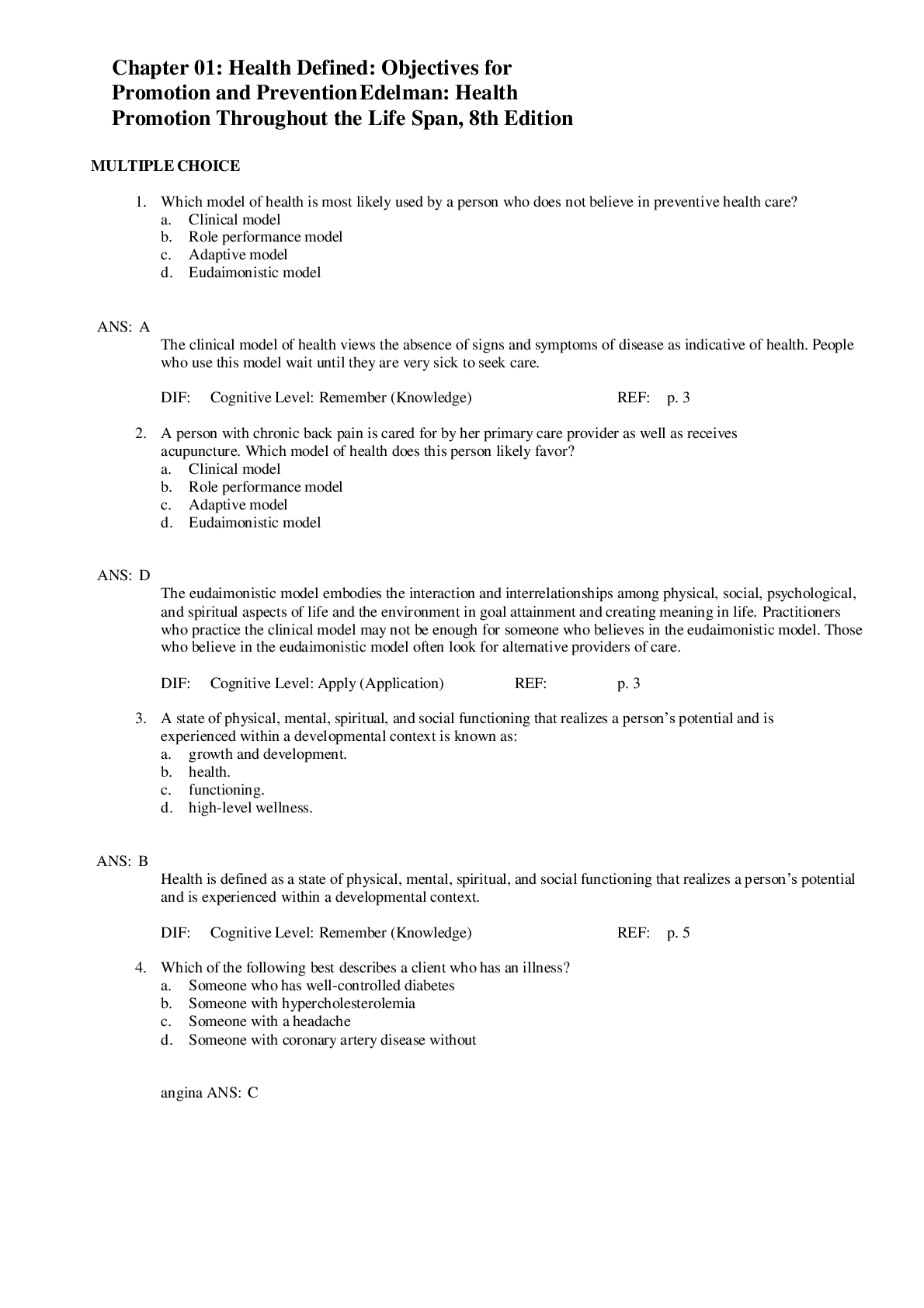

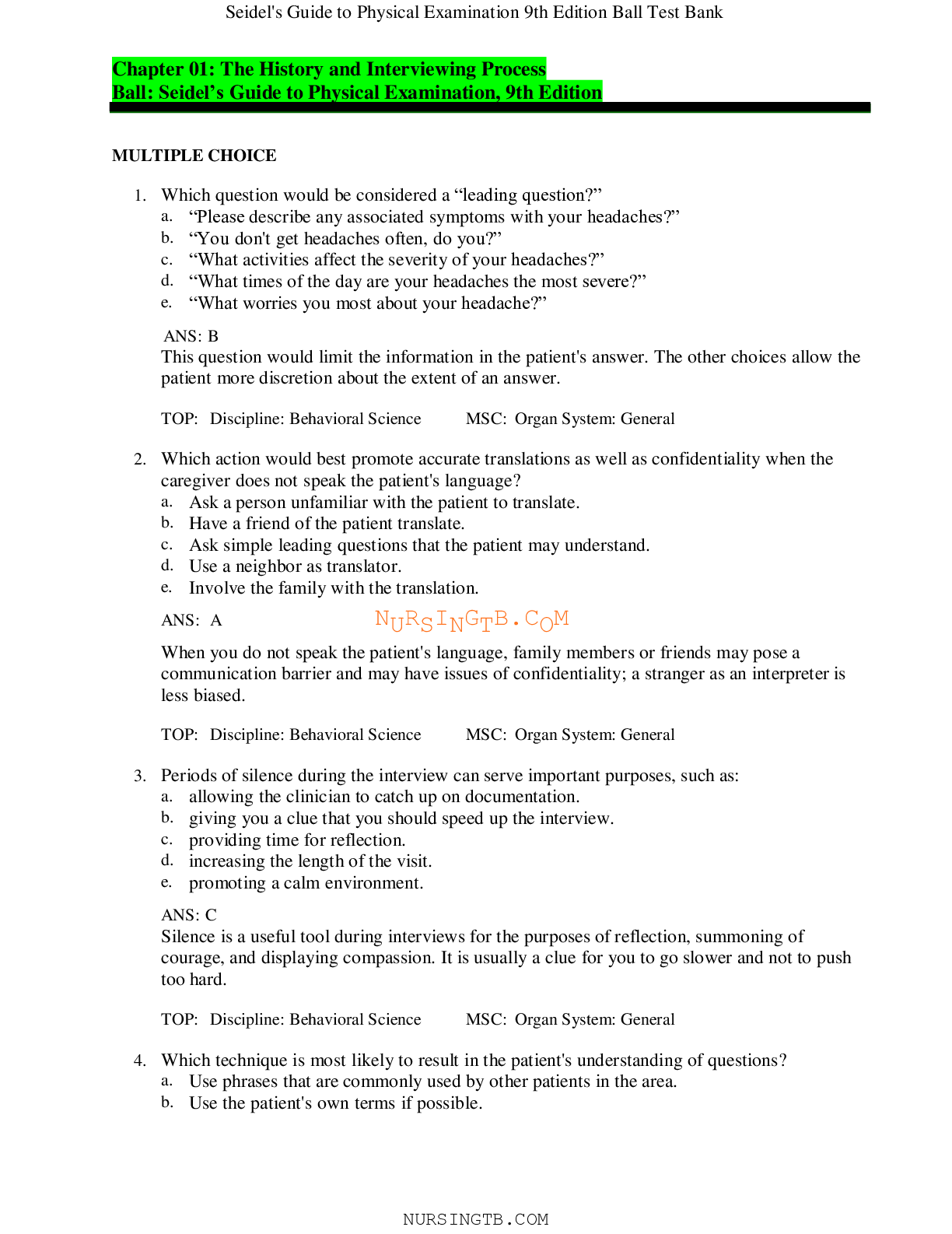
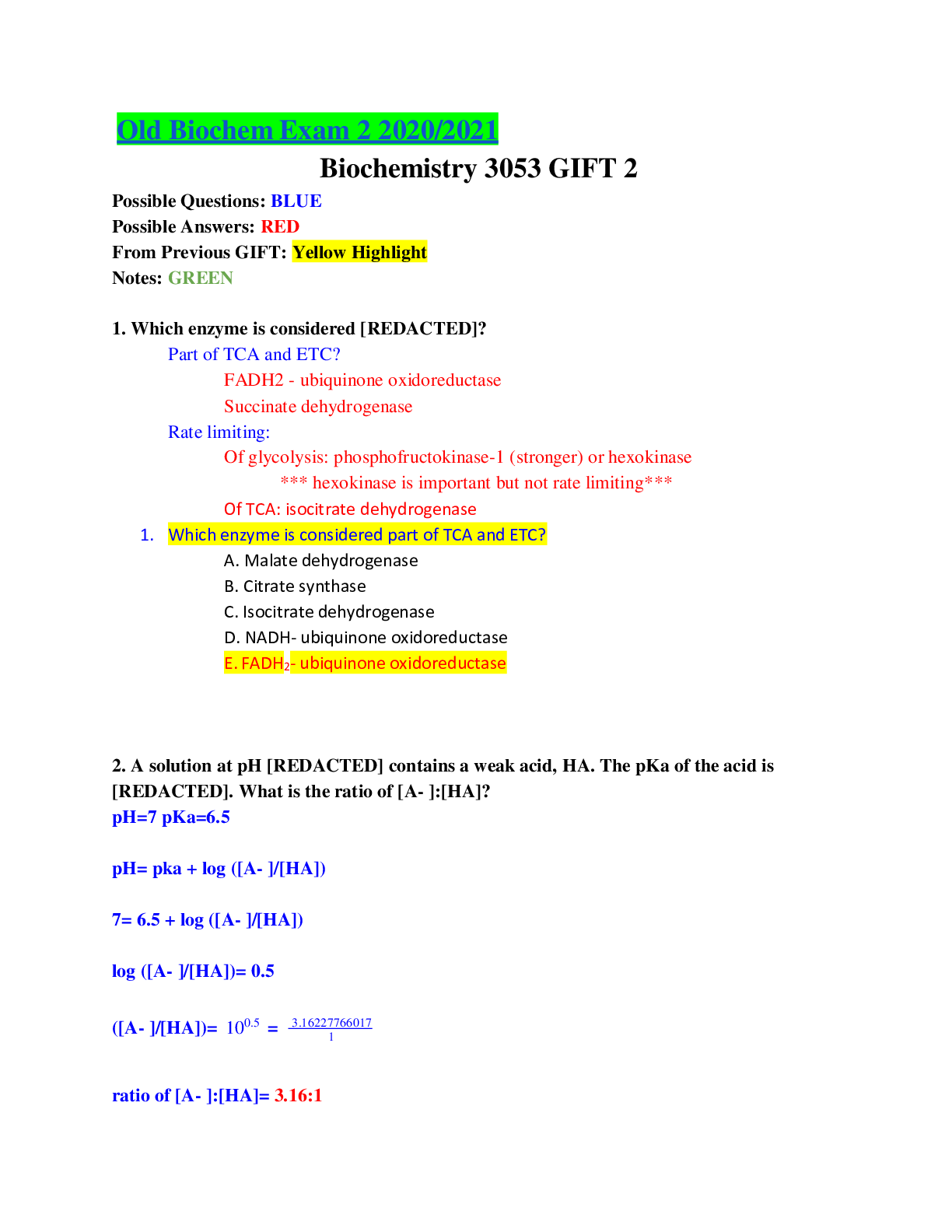
.png)


